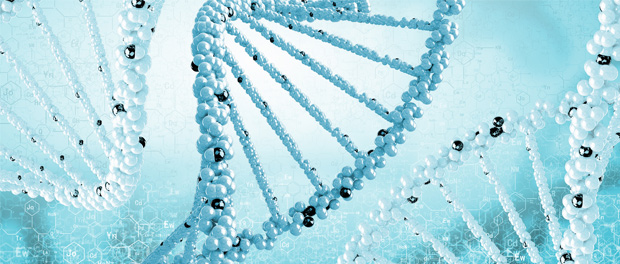
Every cell in the human body contains every human gene. However, not all genes are expressed, or turned “on”, in each cell. Depending on the type of cell, certain genes will need to be expressed and others not. For example, a heart cell possesses genes necessary for appropriate kidney function, but in a healthy heart cell these genes won’t be expressed. Similarly, a kidney cell has genes for proper heart function, but only the genes relevant to kidney functioning should be turned on. When a “wrong” gene is expressed, it can result in uncontrollable cell growth, or cancer. According to research, scientists know that there are small epigenetic proteins inside cells that sit on top of the genetic code that control whether genes are activated or not.
Scientists at the University of North Carolina School of Medicine discovered that a protein that regulates genes, known as Bre1, needs to be maintained at a proper amount in order for other epigenetic players involved in gene regulation to carry out their jobs correctly. According to their research, Bre1 appears to be a major coordinator involved in the process that controls the transformation of a healthy cell into a cancerous one. Specifically, the researchers assessed the monoubiquitylation of histone H2B on Lys123 (H2BK123ub1) and delved into how exactly this epigenetic modification is regulated.
Epigenetics is a growing field that investigates the environment and the factors that control the expression of genes. It focuses on the players “above” the genetic code with the ability to change the phenotype without altering the genotype. Histones are important players in gene expression, as they package genes within cells, allowing them to carry out cellular functions that are necessary to keep us healthy. Certain missteps in the process can cause the improper expression of genes, turning certain genes on when they should really be inactive, which could lead to, for instance, rampant cell growth.
“I think epigenetics is a new frontier of cancer research,” said Brian Strahl, Ph.D., a professor of biochemistry and biophysics in the UNC School of Medicine and a member of the UNC Lineberger Comprehensive Cancer Center. “We can now sequence the entire genome of a cancer cell, and what we’re finding is that many cancers have mutations in the epigenetic machinery. We’re not just finding this in cancer cell lines in the lab but in cancer patients.”
Strahl explained that there are important questions surrounding the exact mechanism by which histones coil up DNA into chromatin, thereby denying or enabling access to the genetic information within our cells.
Strahl aims to find out exactly how histones are involved in basic biological functions and how they are involved in cancer and various diseases. Adding difficulty to this major question is the fact that histones are not all the same. “We’ve already learned that the histone proteins found at the sites of genes can be chemically modified with a variety of small chemical “tags” that either promote or further prevent access to our genetic information — our DNA. And this access or denial ultimately affects genes so they are either activated or not.”
A wide range of sources such as environmental factors, our diet, and the collection of biological chemicals can influence the rise of these chemical tags. Maintaining proper nutrition, for example, allows the chemical tags to form and direct histones to properly turn on genes. Poor diet or harmful toxins experienced in our environment, such as cigarette smoke, can impair the epigenetic machinery.
But, the players ultimately in control of the genes are not these chemical tags, but the additional layer of proteins above the histones which attach the chemical tags.
“Something has to ensure that these chemical tags on histones are regulated properly, to ensure that the tags are only present on the right genes at the right time,” Strahl said.
Along with graduate student Glenn Wozniak, the researchers looked at one of the proteins – called Bre1 – that helps add these chemical tags. Bre1 controls another tag known as ubiquitin and, in a sense, hires ubiquitin and allows it to do its job.
With help from ubiquitin, a histone can open up a cell’s chromatin, exposing the genes for activation. The genes become inactivated when ubiquitin completes this process and is detached from the histones. If the genes become indefinitely active and this process goes off-course, then it’s possible for normal cells to turn into cancer cells.
The exact way in which this happened has, until now, remained unclear. Strahl and Wozniak conducted several experiments and found that a precise amount of Bre1 needs to be maintained so that the proper amount of ubiquitin is added to the histones. Using yeast, they showed that “H2BK123ub1 is regulated in part through the protein stability of the E3 ubiquitin ligase Bre1” and that “Bre1 stability is controlled by the Rtf1 subunit of the polymerase-associated factor (PAF) complex and through the ability of Bre1 to catalyze H2BK123ub1.”
“We found that if there’s too little Bre1, then the gene doesn’t turn on,” Strahl said. “If there’s too much, the gene doesn’t shut off. We call it the Goldilocks effect.”
Wozniak added, “We also found that when Bre1 is not needed or when it doesn’t perform its function, it’s removed as a control mechanism. There won’t be as much ubiquitin on histones because Bre1 is not there.”
Previous scientific literature focusing on Bre1 had been mixed. These new results illuminate an epigenetic mystery.
“Some studies indicated that Bre1 had a role as a tumor suppressor,” Strahl said. “Other studies showed that it’s a cancer promoter. So there’s been conflicting evidence about all of this. Now we know. If there’s too little Bre1, the gene won’t turn on.” This could turn off the genes that protect the cell from cancer. “If there’s too much,” Strahl said. “Then the genes might not turn off.” This could potentially trigger the development of cancer.
“When you think about it, Bre1 could be a really good target for a cancer drug,” Strahl explained. “Cancer cells divide rapidly. A lot of chemotherapies involve creating DNA damage within all rapidly dividing cells. But if you just target the Bre1 protein and maybe shut it off, you could have very bad outcomes specifically for rapidly dividing cancer cells. They wouldn’t be able to transcribe genes anymore.”
Source: Learn all about it and read more about their findings here: G. G. Wozniak, B. D. Strahl. Catalysis-dependent stabilization of Bre1 fine-tunes histone H2B ubiquitylation to regulate gene transcription. Genes & Development, 2014; 28 (15): 1647.
References: UNC Healthcare and UNC School of Medicine. All the Cell’s a Stage. 2014.


